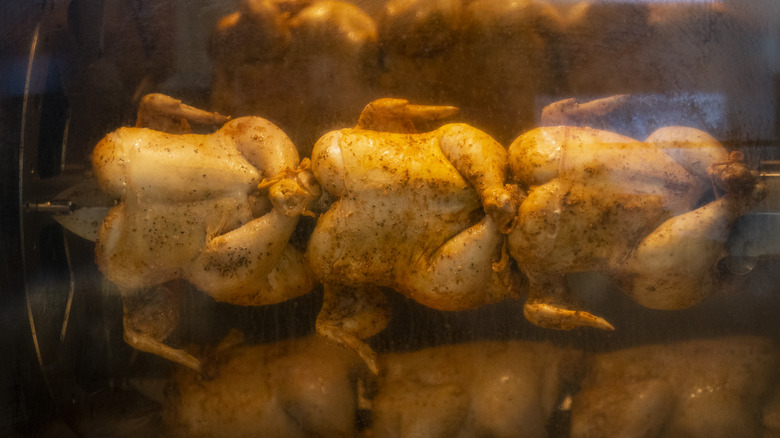The Best Way To Re-Crisp Flabby Rotisserie Chicken Skin
A rotisserie chicken is pretty much a full meal in a plastic box. Do you want a meal that isn't greasy fast food or pizza? Do you want to have something quick and easy on the table that you don't even have to cook? Rotisserie chickens, whether from Costco or your local grocer, are a great solution to any of these problems. You can eat rotisserie chicken in a variety of different ways.
You can cut it apart and serve it as it is with whatever side dish you like, just as you would a chicken you prepared yourself. You can use it as a quick way to make homemade chicken noodle soup without the run-around of making chicken breast ahead of time (via Southern Living). You can also toss some shredded chicken breast in a slow cooker with some cream cheese and hot sauce to make some buffalo chicken dip in under a few minutes (via Food Network). Of course, if you're in a real hurry, you could even just pick at it with a knife and fork and it would still taste pretty good!
But there's one flaw that you may find with your case of lemon pepper-flavored rotisserie chicken: the skin (aka that flabby, wet, chewy part of the chicken that feels like you're chewing on a piece of chicken-flavored chewing gum). Isn't the skin supposed to be the best part of the chicken? How can you turn something so rubbery and flabby into something you could eat without gagging down?
You can render your chicken skin to make it crispy
When you have a strip of raw bacon in your hand, you can describe it like this: flabby, wet, and rubbery. It's only when you put the strip of bacon in a frying pan and let it cook for a few minutes that the bacon crisps up. This is the process of rendering, which Cuisine at Home describes as the method in which fat is melted from meats like pork or bacon. Rendering is the process that you'll use to prepare your chicken skin.
According to America's Test Kitchen, you have two methods of "frying" your chicken skin. If you're using the stovetop, place the skin bottom-side down into a cold skillet and then cook over medium-low heat. Much like how it looks when you fry bacon, you'll notice the fat pool out around the skins and the edges will start to crisp and turn golden brown, After 10 minutes, flip the skins and allow the other side to crisp up, before transferring to a paper towel-covered plate to cool.
If you're using your broiler, place chicken skins bottom-side down onto a foil-lined baking sheet and place it in the oven for two to four minutes until the skin has crisped up. You can serve the fried chicken skins on their own or you can serve them on a sandwich for a bit extra flavor and texture. Think of them like a cross between bacon and potato chips.
You can also use the chicken bones
In today's times, food isn't exactly getting any cheaper, and you want to make every scrap of that rotisserie chicken count. While you can serve the meat and fry up the skins, what exactly can you do with the mess of chicken bones you have sitting in the container?
According to 12 Tomatoes, those chicken bones, along with any other scraps of fat and chicken bits, are key ingredients to making a homemade stock. By simply adding carrots, celery, onions, and garlic to a pot alongside your chicken bones and other herbs, you can easily make a delicious and flavorful stock. It will not only taste better than the pre-bought stuff at the store, but it will also help you save money too because the stock can be used for a variety of different dishes.
If you find yourself with an excess of leftover rotisserie chicken, The Kitchen Community suggests a wide variety of dishes you can prepare, ranging from chicken salads, barbeque sliders, chili, nachos, and even enchiladas. Any dish that you could normally prepare with chicken is perfect to use up leftover rotisserie, as the chicken is already pre-cooked and needs no time to prepare.


